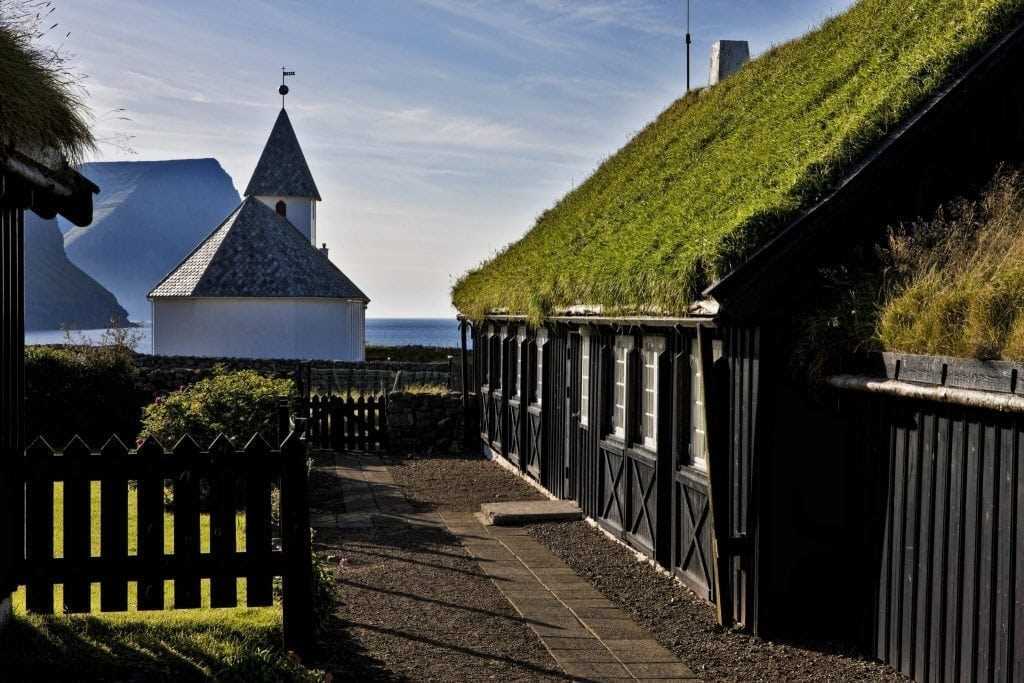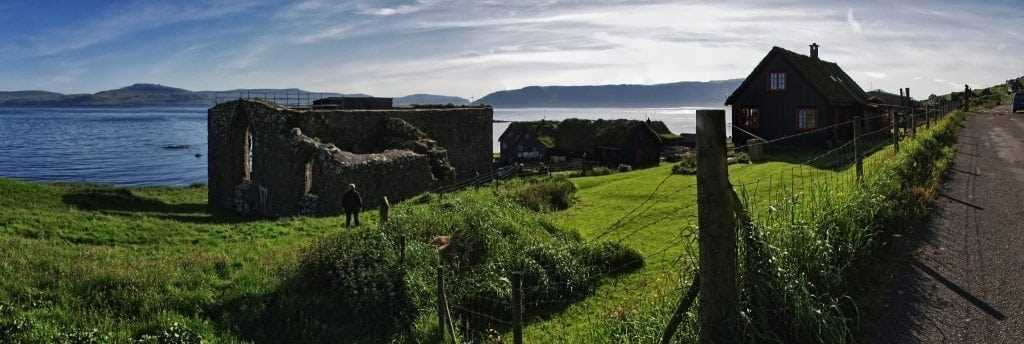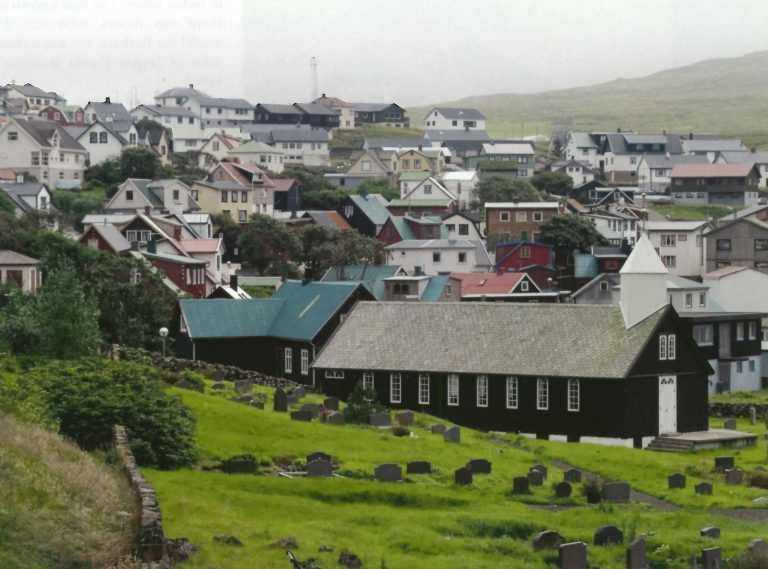A History of the Settlement of the Faroe Islands
The Faroe Islands were colonized by Vikings in the late 9th century. The main historical source for the settlement is the Færinga saga, written in Iceland about 1200. It tells that during the reign of the Norwegian king Harald Fairhair many objected to his unification politics and fled to other countries, including the newfound lands in the west. Place names from the oldest settlements are evidences of settlers also coming from the British coast and the Scottish islands.
The Norse settlers built communities on the model of their homeland. There was plenty of land suitable for grazing of sheep and other domestic animals, and birdcliffs with thousands of seabirds. The sea was abundant with fish, whales and other mammals, and driftwood for housebuilding. Timber for boatbuilding and other necessaries were imported from Norway, in exchange with dried fish, wool and other products.
The history of the Faroe Islands in the Middle Ages is still rather fragmentary, but our knowledge is being supplemented, as archaeological excavations produce material for investigation and interpretation as well as what other historical matters may turn up.
Christendom was introduced around 1000, and a bischopric was established at Kirkjubøur. The ruins of the Magnus Cathedral, the building of which was begun sometime around 1300, is still to be seen today. A still older church at Kirkjubø, Olavskirkjan, dating back to the 1200s, is still in use.
The Norwegian king established overlordship over the Faroes in the Middle Ages. In 1380 the crowns of Norway and Denmark were united for dynastic reasons. The Faroes, like Iceland and Greenland, followed Norway into the union with Denmark, but remained long to be considered a Norwegian dependency.
In matters of the Church the Faroes belonged to the Arch Diocese of Norway and were part of Norwegian jurisdiction. In terms of administration, trade and culture Bergen was the most important connection.
The Legend of the Giant and the Hag
A legend tells how, once upon a time, the giants in Iceland decided that they wanted the Faroes. So a giant and a hag (his wife in some versions of the story) were sent to the Faroe Islands to bring them back with them.
They reached the north-westernmost mountain of Eiðiskoliur, and the giant stayed in the sea while the hag climbed up the mountain with a strong rope to tie the islands together so that she could push them onto the giant’s back. However, when she attached the rope to the mountain and pushed, the northern part of the mountain split. Further attempts were also unsuccessful, even though they struggled through the night, the base of the mountain was firm and they could not move it.
If the sun shines on a giant or other fairy-tale creatures, they turn to stone. So it was that as they struggled, they didn’t notice the time passing, and as dawn broke, a shaft of sunlight put a stop to their efforts by turning them into stone on the spot. They have stood there ever since, staring longingly across the ocean towards Iceland.
Early Modern Period
During the 14th and especially 1 5th century the communication with Copenhagen was strengthened at the expense of Bergen. Over time the Faroes fell under strong Danish influence in step with the consolidation of the powers of the state.
With the Reformation, introduced to Norway and so also to the Faroe Islands in the 1530s, the Catholic bishopric was abolished and the islands were made part of the bishopric of Bergen, and from the beginning of the 1600s part of the bishopric of Sjælland.
The trade connection was also gradually moved from Bergen to Copenhagen. Commerce had in the 14th century been dominated by Hansa merchants, but was later granted as a privilege to various individuals and companies. While dried fish had been the main export article as long as commerce went via Bergen, woolen products, especially stockings, became the most important article after the main trading centre in 1619 was transferred to Copenhagen.
In 1655 the islands were given in fief to a Danish nobleman Christoffer Gabel, who in 1662 was also granted the sole right of trading. When he died he was succeeded by his son Frederik, and the Faroes remained a his fief until 1709, when the crown resumed direct control in place of the indirect rule exercised by the Gabel family. At the same time the Danish crown took over the trade on the islands. Prompted by the numerous complaints from the Faroes during the Gabel rule and trade, the Danish crown hired a commission to investigate the state of the islands, who delivered a detailed report on ecclesiastic as well as civil matters, and the administration of justice and trade. After a period with administrative reform and tidying up, the Faroes were in 1720 combined in a single province with Iceland, and remained so for about 50 years when they were incorporated in the Sjælland province.
In the late 1700s, several administrative changes were made in the management of the trade. In 1774 the Faroe royal monopoly trade was combined with that of Finmark and Iceland, and in 1781 with the Greenland trade as well. The royal monopoly for Finmark and Iceland were soon after abolished, but not for the Faroes. In fact, the royal monopoly trade in those islands was not abolished until 1856.
In the 1800s the Faroes were more integrated in the Danish central administration. I 1814 Denmark, which in the Napoleonic wars had been allied with France, ceded Norway to Sweden but kept the Norwegian dependencies of Greenland, Iceland and Faroe.
Through an administrative reform in 1816 the old Løgting was abolished, and the Faroes were given the status of a Danish province. Until then, the two main functions of the Løgting were to serve as a court of appeal for the trial of civil and criminal cases, and as a forum for complaints from the inhabitants on the conduct of officials and the quality and quantity of supplies handled the royal monopoly trade. The local representative in Faroe of the Danish central power became the “Amtmand” (High Commissioner), who like other officers of state had the required education to occupy positions as ecclesiastic and civil servants.
The Language
Faroese (føroyskt) is a West Nordic or West Scandinavian language spoken by 48,000 people in the Faroe Islands and about 15,000 Faroese in Denmark. It is one of three insular Scandinavian languages derived from the Old Norse language spoken in Scandinavia in the Viking Age, the others being Icelandic and the extinct Norn, which is thought to have been mutually intelligible with Faroese.
At one point the language spoken in the Faroe Islands was Old West Norse, which Norwegian settlers had brought with them during the time of the “landnám” (settlement) that began around AD 825. However, many of the settlers weren’t really Norwegians, but descendants of Norwegian settlers in the Irish Sea. In addition, native Norwegian settlers often married women from Norse Ireland, the Orkneys or Shet lands before settling in the Faroe Islands and Iceland. As a result, Celtic languages had some influence on both Faroese and Icelandic.
Between the 9th and the 15th centuries a distinct Faroese language evolved, although it was still interchangeable with the Old West Norse language.
Until the 15th century, Faroese had a similar orthography to Icelandic and Norwegian, but after the Reformation in 1538 the ruling Danes outlawed its use in schools, churches and official correspondance. The islanders continued to use the language in ballads, folktales, and everyday life. This maintained a rich spoken tradition, but for 300 years the language was not written down.
This changed when Vencelaus Ulricus Hammershaimb published a written stan-dard for Modern Faroese in 1854. Although this would have been an opportunity to create a phonetically true orthography like that of Welsh, he produced an orthography consistent with a continuous written tradition extending back to Old Norse. The letter ð, for example, has no specific phonemes attached to it.
In 1937, Faroese replaced Danish as the official school language, in 1938 as the church language, and in 1948 as the national language by the Home Rule Act of the Faroes. Today Danish is considered a foreign language even though around 5% of the Faroe Islanders learn it as a first language and it is a required subject for students 3rd grade and up.
The Faroese alphabet consists of 29 letters: A, Á, B, D, Ð, E, F, G, H, I, í, J, K, L, M, N, O, Ó, P, R, S, T, U, Ú, V, Y, Ý, Æ, 0
The National Movement
With the Reformation Latin was to be replaced be the vernacular, and Danish language became the language of the Church of the whole Danish-Norwegian Monarchy. With the increasing concentration of trade and governmental rule in Copenhagen, Danish also became the language of law and administration. But Faroese was preserved as the spoken language, and as a cultural mode of expression it was passed on in the form of ancient ballads, legends, adages etc. until it was transformed into written form at the end of the 18th and especially in the mid-19th century.
Under the influence of National Romanticism various Danish scientists undertook the task of collecting and writing down Faroese folk culture. It led to an increased need for a standard Faroe written language. It was in the 1840s construed by W. U. Hammershaimb, one of the few Faroese who from the mid-1800s got an academic education in Copenhagen. He was a theologian but had in addition acquired the necessary philological knowledge to work out a grammar and orthography of Faroese. Modern Faroese writing still rests on Hammershaimb’s orthography.
Late in the 1800s the number of Faroese who went to Copenhagen to get an academic or other education became numerous enough to make up a Faroe enclave. Many of them communicated the ideological currents of their time and became pioneers in the development of a national Faroe culture and other social features.
Thus the national movement came into being among Faroe students in Copenhagen, where in 1881 they founded the Faroe Fellowship. A few years later, in 1888, the “Føringafelag” (Society of Faroese) was founded in Tórshavn. Both associations were inspired by the national and other cultural ideas of the time. They emphasized the common ethnicity and descent from Norwegian Vikings. The Faroese language became from the start one of the most important symbols of the cultural fellowship. The development and spreading of the language held high priority. Modern literature came to life, and poems on the nature, the people and the new concepts like freedom and growth became part of the communication of a new national identity. The ancient ballads accompanied by the chain dance gained new contents as representing a unique Faroe culture different from other cultures. So the first stage was a cultural movement, but turned into politics and became the ideological foundation of an independence movement influencing all debate on the political relations with Denmark.
Religion
Almost everybody in the Faroe is a Christian. 84% belong to the People’s Evangelical Lutheran Church. Some 14% are part of the Plymouth Brethren Church which arose at the beginning of the 20th century, inspired by the Scotsman William Gibson Sloan. 5% of the Faroese belong to other congregations like the Pentecostal and the Seventh Day Adventist Church. The Catholic Church in Tórshavn has 70 members. There are also smaller groups of other believers, like the Jehovah’s Witnesses and Baha’i.
Tradition and Modernity
The 19th century is in many respect the era of the conflict between a traditional and a budding modernist view of society.
An important event in the middle of the 1800s was the introduction of a new Danish constitution based on democracy in stead of absolute monarchy. The constitution was extended to include the Faroes, and the Faroese people were entitled to elect two members to the Danish parliament. The old institution, the Løgting, was reconstituted as a consultative organ for the Danish government, but without legislative or taxation power.
Until the mid-19th century Faroe must be described as an agrarian society mostly based on sheep rearing. But fishing was an important supplement. As the population grows, so does the number of open rowing boats for coastal fishing, while fish products make up an increasing proportion of exports.
In 1856 commerce and industry is freed through the abolition of the Royal Trade Monopoly. In the last decades of the 19th century men begin acquire a fleet of decked smacks for ocean fishing. It meant a lot of new jobs for the population. The merchants were typically ship owners as well. They bought and sold fish and agricultural produce and so diversified the subsistence economy. But they also increased their customers’ dependence upon the merchants, for the money economy remained underdeveloped, and wages often paid in goods.
Between 1900 and 1920 the population grew from 15.000 to 21.000 and the fishing fleet from 87 to 144 vessels. The years up to WW I is described as a beneficial period. For various reasons the fisheries took a downturn in the late ’20s, when the great depression set in and lasted till the late ’30s. The economic difficulties in the fishing industry impacted on the means of the public sector to function. The Danish state had to undertake a growing share of the public expenses and to subsidize industry. But the support was limited, and both industry and the public sector were plagued by a shortage of capital. Economic hardship therefore came to play a large role in political life.
The political relations with Denmark were at times debated, and at the same time people were preoccupied with the language issue. Danish had gained further influence in the 19th century through the introduction of public primary schooling, which was not adapted for Faroe conditions. The principle that Danish was to be the only language permitted for teaching purposes had been stipulated by law in 1912. Repeated efforts to recognise Faroese as the language of teaching remained moot until 1938, when the controversial legal clause was scrapped at last. The negative Danish attitude was justified by the internal split in Faroe opinion on the language and other national questions.
World War 2 and the Aftermath
During the Second World War Denmark the Faroes were occupied by opposing sides: Denmark by Germany, whereas British troops took control of the Faroes. The five year separation meant that the Danish government was unable to exercise its powers in the Faroes, and a preliminary constitutional settlement was agreed upon and the Løgting, dividing the powers between the governor (amtmand) and the Løgting. The arrangement gave the Løgting more legislative and financial influence than it used to have. The fishing fleet was engaged in supplying wetfish to Britain and experienced unprecedented prosperity by selling fish at high wartime prices. These favourite circumstances fostered a belief among the Faroese in themselves as a selfsufficient community able to handle all its affairs.
The war-time constitutional arrangement lasted until 1948. When the war was over both the Danish government and the majority of the political parties in the Faroes realized the necessity of adjusting the islands’ status in the Danish Kingdom with a view to more autonomy. Prolonged and difficult negotiations between Faroese politicians and the Danish government resulted in a compromise with the Home Rule Act of 1948. It set the guidelines for the division of areas of administration between Denmark and the Faroes and thus recognized a competence for the Faroese authorities, consisting of the parliament (the Løgting) and its executive (the Landsstýri) to legislate and administer a number of areas. Exceptions of areas transferable to the Faroese administration are judiciary, foreign affairs, defence and currency.
In spite of the fact that foreign affairs are in the hands of the Danish government only, the Home Rule Act contains certain guarantees to the Faroes, e.g. participation in Danish negotiating delegations, and negotiations by the Faroese alone. Recently the Danish and the Faroese governments have agreed upon a policy of gradual transfer of powers to the Faroes with a view of adapting Faroese administration towards full independence, and to strengthen the role of the Faroese authorities in international relations.
Even in the late 1950s Faroe was a backward country compared to Scandinavia. Since the 1960s great sums of money have been invested in development and in the adaptation of industry, infrastructure, public institutions, education, health and social welfare systems. On the way there have been economic recessions and one slump. But today Faroe is a dynamic society, and the population has passed 48.000. The fisheries and associated businesses are still the driving force in the Faroe economy. Fish related products make up 95% of the export value of goods. This imbalance makes the economy vulnerable to swings in the size of fish stocks and market prices, and one of the major challenges lies in regulating fishing to avoid overfishing and to optimize the utilization of catches.
Besides it is a goal to develop other competitive industries. Recently the drilling for oil in the Faroe continental shelf has raised hopes of finding oil off the islands. If they succeed, it will mean opportunities for a new source of wealth, but also new challenges for expertise, investments and the ability to steer developments.


